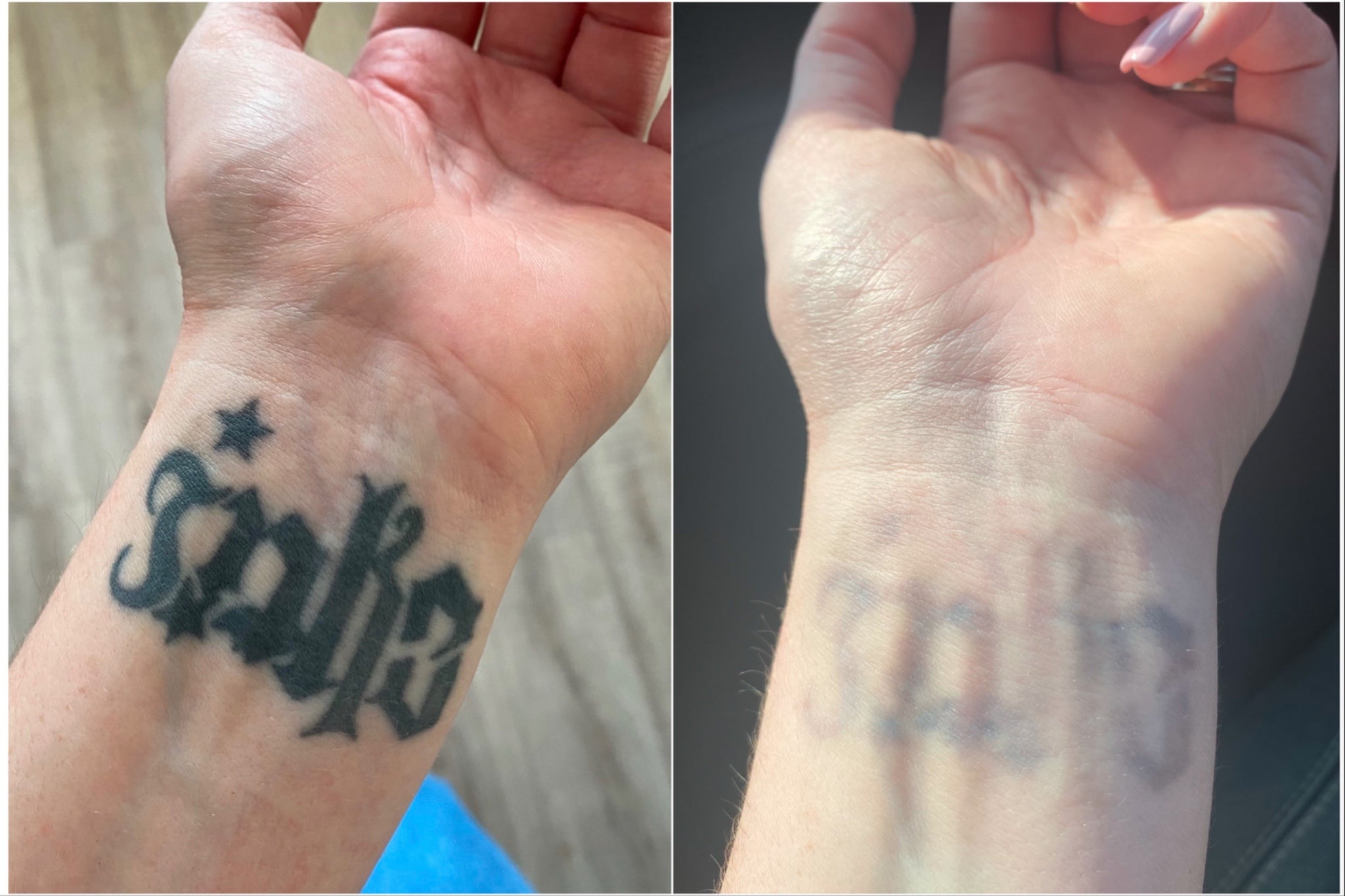
A tattoo is for life, right? Or at least, that’s what concerned grown-ups would always claim while trying to discourage your 18-year-old self from getting inked on holiday. But the truth is much less black and white – or should that be blue-ish and white? – as comedian Pete Davidson has found out.
About four years ago, the former Saturday Night Live star started getting rid of around 200 tattoos. Earlier this month, he showed off the results by posing in his pants in an ad campaign for fashion brand Reformation, looking pretty much ink-free. For Davidson, it’s been a long and apparently painful slog. “It’s horrible,” he told Jimmy Fallon during an appearance on The Tonight Show. “It’s worse [than getting a tattoo]. They’ve got to burn off a layer of your skin.”
Is it really that bad? Modern tattoo removal doesn’t involve “burning off” the skin; that bit is pure Davidson comedic licence. But eradicating your body art is certainly a drawn-out process, one that’s lengthier (and more painful) than getting tatted up in the first place. The most common way to get rid of a tattoo involves laser technology, using high-intensity pulses of light to break down ink particles in the skin. Once they’re small enough, “these are then naturally cleared away by the body’s lymphatic system”, explains Dr Dev Patel, aesthetic physician and founder of Perfect Skin Solutions Clinic in Portsmouth. Sessions are “spaced six to eight weeks apart to allow the body time to clear the fragmented ink”, he adds. The “gold standard” in tattoo removal, Patel says, is a “picosecond laser”, which “delivers ultra-short pulses of energy” – so short, in fact, that they are measured in trillionths of a second. They break the tattoo pigment into even smaller fragments, which are easier for the body to absorb and remove.
Davidson has reportedly blown around $200,000 (£159,000) so far on his quest to turn his body back into a blank canvas. The typical customer probably won’t need to spend anywhere near that amount, but the cost of tattoo removal certainly adds up. “On average, small tattoos start from £50 per session, and larger tattoos may be £100 plus per session,” says Dr Patel. Take into account the fact that most designs will require six sessions minimum and you’re looking at a hefty investment.
About a year after her son was born, personal stylist Lindsay Edwards decided to get his name inked on her wrist. “I chose a very delicate, fine line italic script and it looked lovely when it was first done,” she says. “I was so pleased with it.” But as time went on, “the ink started to bleed out, so it became very smudged around the edges and wasn’t really what I’d wanted”. Her first step was to cover it up with a new design. By then, she’d had another son, and her tattoo artist worked out a way to meld both their names into an ambigram, a design that can be read in different ways depending on perspective. Although she “appreciated the cleverness of it”, the tattoo 2.0 was “much bigger than I ever initially wanted, blocky and bold and not really me”.

More than a decade later, Edwards got to the point where she wanted to remove it. Another cover-up wasn’t an option, “because it just meant going even larger” – and a full sleeve didn’t exactly appeal. For the past year and a half, she has visited a tattoo removal studio in St Albans every six weeks or so; she’s now gearing up for her 12th session. Another “four or five” should get rid of it completely: it’s taken so long “because it was a very heavy pattern, with the ink tightly packed in, and because of the fact it was a cover-up”. Her sons, now teenagers, inevitably “keep teasing me about it. They’re like, ‘That’s it, you’re erasing us!’”
Of course, there’s one thing that everyone really wants to know about getting rid of tattoos: how much does it hurt? Ask people who’ve gone through it and you’ll hear a lot of similes involving elastic bands. “It’s like being pinged with a red hot rubber band about a million times a second,” says Sarah Wellband, a remedial hypnotist who has had a small rose design removed from her chest; for her, the pain of removal far exceeded the discomfort of getting the inking done in the first place.
Jools Aspinall, a leadership consultant who is currently in the process of removing three tattoos, “all done on a whim at different points in my life”, had a similar experience. “It is painful, much worse than getting the actual tattoo,” she says. “The removal itself feels like being flicked with an elastic band that is on fire over and over again.” For Edwards, it’s more akin to “if you’re frying something and the hot oil catches your skin … When they’re actively doing it, it’s very painful, but once it’s done, it feels hot and a bit sore for maybe an hour or so, but then it passes really quickly … It’s absolutely worth it for me”.
I’ve had some people who’ve been on the stag do, who were drunk and didn’t even know they got the tattoo, they were so mortified that their wife-to-be was gonna find out
When Rachael Hyland meets clients for tattoo removal at Radiant Living Medispa near Wigan, she advises them that “if you’ve had the tattoo in the first place and you coped with the pain, you’ll be fine with [the process] now”. Although it “isn’t pleasant”, the first few seconds are the worst, as afterwards, “your body starts to produce a bit of adrenaline. Your body gears you up so you become a bit more numb to it”. Her clinic provides numbing cream and uses a cryocooler, which “blows air out at up to -20C, and that really numbs the pain as well”.
No tattoo is the same, and there are plenty of factors that will impact exactly how long the removal process takes. Tattoos on the extremities of the body tend to take longer to eliminate. Essentially, “if your ink is further away from your heart”, Hyland says, it will take longer, because the blood flow is lower. “If I had exactly the same tattoo on my ankle and my shoulder, and we did the exact same treatment at the same time, the one on my shoulder would go quicker because your heart has to work less hard and your immune system has to work less hard to remove the particles there.” And “if someone smokes [or] drinks a lot, then they are compromising the immune system, so therefore the tattoo removal journey will take longer”. In 2012, researchers in Milan discovered that smoking can reduce the chance of successfully getting rid of a tattoo after 10 treatments by as much as 70 per cent.

Different ink shades also respond to lasers in different ways, because each absorbs different wavelengths of light. A picosecond laser should be able to get rid of most colours, but if you’re being treated with a more traditional Q-switched laser, “a Ruby [laser] is the best one to remove green ink, whereas Nd:Yag [laser] is best for black and blue inks”, says Hyland. “To get rid of reds, browns, oranges, you need a KTP laser, which is a green light.” Sometimes, she adds, it can be tricky to find a studio that has the technology required to get rid of every colour.
Your skin tone affects the process, too. Darker skin has more melanin, which can absorb more of the laser’s light energy, and requires “careful laser selection and lower energy settings”, cautions Dr Patel, to avoid hypopigmentation or hyperpigmentation (skin discolouration caused by too little or too much pigment).
After the treatment, “the skin may feel warm, swollen or slightly tender, similar to mild sunburn”, says Dr Patel. You might experience redness or pinpoint bleeding, “but this typically settles within a few hours to a few days”, he adds. Blistering might occur, too. In between sessions, you’ll need to steer clear of sun exposure, apply high-factor sunscreen and avoid picking at the area. If the skin is clear, without scabs or blisters, massaging the skin can help stimulate the blood flow.
Hyland says she often gets bookings from brides-to-be, trying to get rid of their body art before walking down the aisle. “[With] anything that’s visible around their neckline, on their wrist, you get a lot of brides suddenly thinking, ‘Oh my God, this tattoo’s gonna be on show, what am I gonna do?’” she says. Often, though, they underestimate just how long it takes. “They’ll come in March and go, ‘I’m getting married in August, can you get rid of this?’” That’s not the only type of pre-nuptial customer she’s seen. “I’ve had some people who’ve been on the stag do, who were drunk and didn’t even know they got the tattoo,” she says. “They were so mortified that their wife-to-be was gonna find out, so they had to get rid of it.”
Breakups are another common catalyst – although Wellband’s tattoo story is almost the exact inverse. She began removing hers because her then-partner “hated it”. She didn’t feel particularly “emotionally attached” to the design, so she agreed – but the lengthy removal process eventually outlasted the relationship. “It was literally a couple of days before the final treatment that we split up.”
Will a tattoo ever disappear entirely? Again, it depends on the size and complexity of the design. Some will completely fade, says Dr Patel, especially with picosecond laser treatment. However, he cautions, some people “may experience residual ghosting’ – where the skin retains a white shadow of the original design – or slight pigmentation changes. “Skin type, ink colour and tattoo depth play a major role”, he adds. For the first year after removing her tattoo, Wellband says she could see “a very faint outline”, but now, the only thing she notices is that when she sunbathes, the site of her old tattoo doesn’t tan like the rest of her skin.
And if you really want to start the whole cycle over again, you can “absolutely” get inked on the same spot once the skin has healed, Hyland says. “I’ve had a guy who had a really dense tattoo, and we got rid of it so [there was] virtually nothing left, then he went and got another tattoo,” says Hyland. Months later, he returned, having gone off the second design. “He had it done, went and had another tattoo, came back and started all over again in exactly the same place.”







